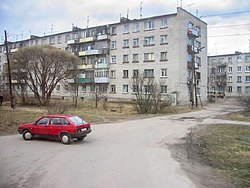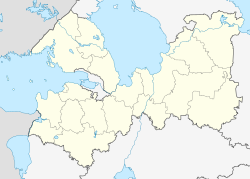Svetogorsk
Svetogorsk
Светогорск | |
|---|---|
 Apartment buildings in Svetogorsk | |
| Coordinates: 61°6′30″N 28°51′30″E / 61.10833°N 28.85833°E | |
| Country | Russia |
| Federal subject | Leningrad Oblast |
| Founded | 1887 |
| Government | |
| • Body | City Council of Deputies |
| Elevation | 44 m (144 ft) |
| Population | |
| • Total | 15,973 |
| Time zone | UTC+3 (MSK |
| Postal code(s)[3] | |
| Dialing code(s) | +7 81378 |
| OKTMO ID | 41615114001 |
| Website | eng |
Svetogorsk (Russian: Светого́рск; Finnish: Enso) is an industrial town in Vyborgsky District of Leningrad Oblast, Russia, situated on the Karelian Isthmus, on the Vuoksa River. It is located one kilometer from the Russian–Finnish border, five kilometers from the Finnish town of Imatra, and 207 kilometers from St. Petersburg. Population: 15,698 (2002 Census);[4] 15,594 (1989 Soviet census).[5]
History
The town, founded in 1887, was originally called Enso and formed part of the Jääski municipality, in the Finnish Viipuri Province. Enso was developing into an influential town, but the Soviet Union's hostilities against Finland led to its occupation in 1940. In 1941, Enso was returned to Finland, but in 1944, Soviet Union took over it again. After World War II, the town was ceded to Soviet Union. Soviet citizens were transferred to the town after the war (mainly from Ukraine, Belarus, and Russia) and in 1949 town was renamed Svetogorsk.
After the Winter War the Finns and the Soviets disagreed on the interpretation of the peace treaty regarding Enso. The former Minister for Foreign Affairs of Finland Väinö Tanner wrote in his memoirs: "Already now a dispute about the district of Enso developed. According to the map attached to the peace treaty Enso was clearly intended to belong to Finland but the Russians claimed that it should belong to them. Later the map was redrawn according to the interests of the Russians so that the border bends at Enso." [6]
In 1972 the Soviet Union awarded Finland a construction project for a large new cellulose and paper mill in Svetogorsk. The project was paid with Soviet crude oil. The project also gave a start to cross-border relations. Notably, the construction workers in Svetogorsk were called "builders", and the project also had intent to "build friendship between peoples".
Industry
Before the Winter War the town was a major factory site for Enso-Gutzeit Oy, the Finnish pulp and paper company (now Stora Enso). In the armistice of 1940 the new Finnish-Soviet border was deliberately drawn to leave the factory complex on the Soviet side. The town's major industry is still pulp and paper.
OAO Svetogorsk, one of the biggest paper mills in Russia, is the major employer. Covering two square kilometers, OAO Svetogorsk produces pulp, printing paper, and packaging board. Its brands include Svetocopy and Ballet office paper. Since December 1998, OAO Svetogorsk has been majority owned by International Paper. At end of 2001 the plant employed 3,000 people; by 2008 this had fallen to 2,200.[7]
Immediately adjacent to OAO Svetogorsk is a tissue mill. This formed part of the original mill complex but was split-away and resold by International Paper to SCA during the acquisition of OAO Svetogorsk from Tetra Laval, which controlled the plant since 1995. Svetogorsk Tissue, as the separate entity was to be called, became fully integrated into SCA Hygiene Products Division in 2003. It employs around 400 people. Its products include Zewa and Tork brands of paper towels and toilet tissue.
Border
The Imatra-Svetogorsk border plays a key role in the transportation of timber between Russia and Finland. Also, around 150 employees commute daily from Imatra to the paper mills. The border crossing, which had temporary status, was a frequent cause of bottlenecks due to lengthy customs checks and inadequate facilities. A Russia-Finland agreement in 1997 allowed the development and eventual permanence of the border crossing. This €7 million European Union TACIS funded project ran from 1999 and the new international frontier, capable of handling 1,300 cars per day, opened on July 3, 2002. Further TACIS programmes are planned until 2010, including improvements to town infrastructure and the development of an industrial park with special tax rates.
2008 Protests
On the 18th of April, 2008, about 500 inhabitants of Svetogorsk participated in a protest which included a road barricade on the Finnish-Russian border as a protest against poor road conditions and lack of investment in road improvement at both federal and municipal level. According to the Finnish public service broadcaster YLE, the militia participated in effectively cutting off through traffic. The main issue of discontent was the lack of a by-pass, which, according to reports, should already have been built.[8]
Sister city
Svetogorsk has one sister city:[9]
See also
References
- ^ Invalid reference parameter
- ^ "Об исчислении времени". Официальный интернет-портал правовой информации (in Russian). 3 June 2011. Retrieved 19 January 2019.
- ^ Почта России. Информационно-вычислительный центр ОАСУ РПО. (Russian Post). Поиск объектов почтовой связи (Postal Objects Search) (in Russian)
- ^ a b Federal State Statistics Service (21 May 2004). Численность населения России, субъектов Российской Федерации в составе федеральных округов, районов, городских поселений, сельских населённых пунктов – районных центров и сельских населённых пунктов с населением 3 тысячи и более человек [Population of Russia, Its Federal Districts, Federal Subjects, Districts, Urban Localities, Rural Localities—Administrative Centers, and Rural Localities with Population of Over 3,000] (XLS). Всероссийская перепись населения 2002 года [All-Russia Population Census of 2002] (in Russian). Cite error: The named reference "PopCensus" was defined multiple times with different content (see the help page).
- ^ Всесоюзная перепись населения 1989 г. Численность наличного населения союзных и автономных республик, автономных областей и округов, краёв, областей, районов, городских поселений и сёл-райцентров [All Union Population Census of 1989: Present Population of Union and Autonomous Republics, Autonomous Oblasts and Okrugs, Krais, Oblasts, Districts, Urban Settlements, and Villages Serving as District Administrative Centers]. Всесоюзная перепись населения 1989 года [All-Union Population Census of 1989] (in Russian). Институт демографии Национального исследовательского университета: Высшая школа экономики [Institute of Demography at the National Research University: Higher School of Economics]. 1989 – via Demoscope Weekly.
- ^ Väinö Tanner (1950): Olin ulkoministerinä talvisodan aikana. Tammi. P. 415. (In Finnish.)
- ^ [1]
- ^ YLE Uutiset / Kotimaa
- ^ Svetogorsk is getting a sister city





